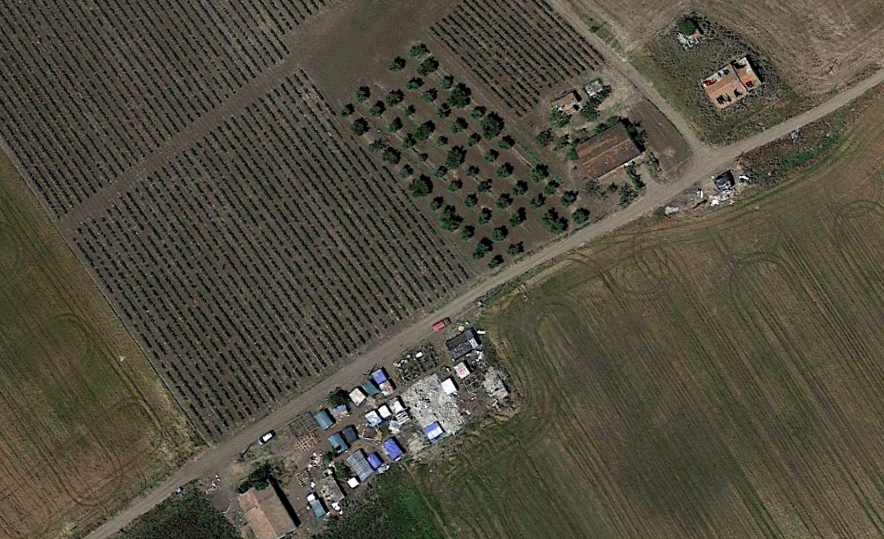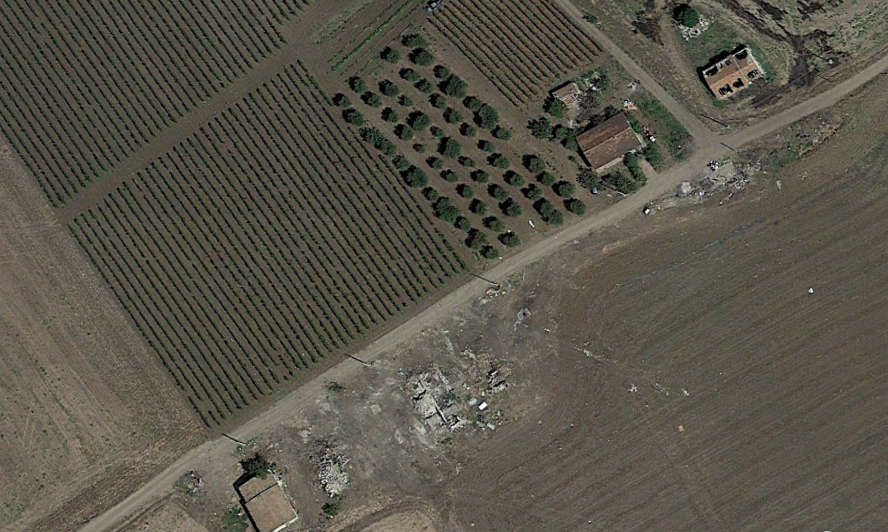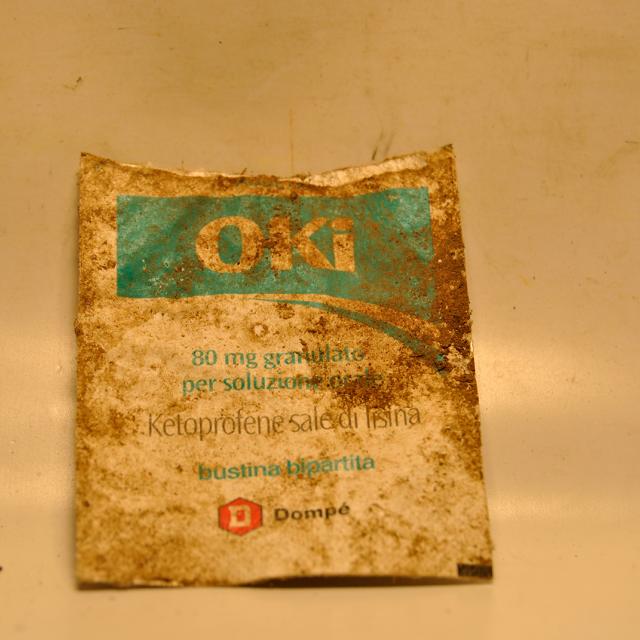How farm workers are wrecked by a corporate food regime in South Italy’s migrant ghettos
This post is the somewhat longer version of a blog contribution I posted on Border Criminologies, as part a collaboration with the journal Geopolitics to promote open access platforms. The research presented here forms part of a monograph published with Cornell University Press and titled The Natural Border: Bounding Migrant Farmwork in the Black Mediterranean.
Caporalato Capital
On a particularly hot day of August 2018, I met Idrissa*. I was talking to one of my acquaintances in the ghetto of Borgo San Nicola*, a run down and abandoned ruin in the middle of the fields of Basilicata, South Italy. Idrissa, who was visibly inebriated, asked me for money to buy him a drink. I asked him to wait. I had met Idrissa a few times before: a young man from Burkina Faso, he lived in a ramshackle room on a farm in the vicinity of the ghetto. Since a couple of years, he had been working as a day labourer on South Italy’s food farms, picking tomatoes and other fruits and vegetables under the boiling sun. My acquaintance, who had come from Burkina Faso to Italy ten years earlier, asked Idrissa if he had finally decided to accept the work, he had offered him: a day of picking tomatoes in neighbouring field. Idrissa shrugged, standing aloof for a moment in the sun. Then, he answered: “my fate is in the hands of God.” Severely, my acquaintance responded: “your fate may be in the hands of God, but K. does not live in heaven, you know” – after which he left and drove off in his second-hand car.
In Italy, there are tens of thousands of young men like Idrissa. They represent what the labour unions call Italy’s vulnerable agricultural labour force: subject to severe labour exploitation, and marginalized socially and spatially, their number has risen exponentially over the past twenty years. According to FLAI-CGIL, around 180.000 of the plus-minus 400.000 ‘foreign’ (without Italian nationality) workers in this sector meet these criteria of vulnerability and marginality; around 40 percent being refugees and asylum seekers – mostly young men from South Asia and Sub-Saharan Africa. These numbers by far exceed the formal hires the Italian government permits through its so-called ‘Flow Decrees’ (Decreti Flussi), in 2023 around 83.000, 44.000 of which concern so-called seasonal labour. Instead, agri-food workers are typically recruited through all kinds of mediating infrastructures that sustain the operations of contemporary supply chain agri-food capitalism: illegal gangmasters (in Italian caporali), ‘cooperatives of convenience’, and, in a growing number of cases, migrant reception centres. In Idrissa’s case, the piecemeal work was offered to him through a tight hierarchy made up of K., a Burkinabè intermediary (commonly called capo nero) and their Italian superior (caporale).

Yet while the illegal gangmasters are often fetishized in the media and in decision-making circles as the main culprits of labour exploitation in agri-food chains, my recent research with Domenico Perrotta shows the functionality of this infrastructure as a grey space that sustains and reproduces inequalities in agri-food labour markets. Furthermore, the persistence of caporalato capitalism goes paired with a concentration of capital in what Philip McMichael calls the ‘corporate food regime’ (even if the discussion remains open on the terminology).
In Europe, for example, scholars have noted a growing monopolization of food production, distribution and marketization by a few powerful players who tend to dominate the entire value chain of agri-food business. As dominant players in global food markets today, supermarket retailers typically avoid direct involvement in production. Instead, they prefer to specialise in controlling marketing and supply chains through quality standards, branding and logistics while they outsource production towards smallholder farmers who are able to diversify risks and subject their production to the conditions imposed by their clients. This has led to a steep dispossession from below: the growing concentration of farm property in the hands of private smallholders whose production is tied exclusively to the retailers’ supply chains. Recent global crises – of the Sars-CoV-2 or Covid-19 virus and the war in Ukraine in particular – have made this tendency even more visible: research by the via Campesina network, by Oxfam and by UNITE conform this tendency of land property concentration: compared to 15 million firms in 2003, only 9.1 million companies currently farm 157 million hectares of land, equivalent to 38 percent of agricultural land in the region (according to Eurostat 2020 data). Italy is a typical case of such dispossession: between 1990 and 2022, the total agricultural surface (superficie agricola totale: SAT) per agricultural firm has expanded from 7.6 hectares to 14.5 hectares, while in during 1982-2022, the number of agricultural enterprises has dropped from 3 to little more than 1 million.

After having commodified the land as a resource for capital’s gain and exploiting it with ever-more insidious techniques of fertilization, seed and crop modification, global agri-food corporations are now intoxicating the planet even further through their deliberate precarization of human labour. During the pandemic, the question arose why agri-food production is not being automated more than it is today. While governments around the globe proceeded with the closure of territorial borders to prevent the corona virus from spreading and negatively affecting national economies, we all witnessed the importance of precarious migrant labour to keep agribusiness going. In Thailand, thousands of migrants from neighbouring Myanmar, Cambodia and Laos returned home at the height of the rice growing season, leaving the country’s large monocultures unattended. Australian horticulture industries saw their labour force evaporate due to Covid visa restriction. Fearing a shortage of 80.000 workers, the British farmers’ Association launched an appeal to constitute a Land Army. To support agricultural production, European agri-businesses were actively trying to recruit students and pensioners to replace the foreign labourers from Eastern Europe. Speaking of a shortage of 200.000 workers, the Italian association Confagricoltura demanded the establishment of “green corridors” to facilitate workers’ mobility. Agribusiness’ calls for assistance ultimately prompted the European Commission to include agricultural workers in the category of “indispensable workers” within its Guidelines issued on 30 March 2020.
Despite these measures, however, the vulnerability of agri-food workers continued to rise during the pandemic, As I discuss in my monograph The Natural Border, to the extent that several medical and socio-judicial organizations denounced the lack of interest in the health of seasonal workers from the part of European governments. In Italy, MEDU and MSF criticized the government’s lack of interest in the health of seasonal workers. In Germany and Italy, meat processing factories and industrial slaughterhouses became prime places of contagion because of the close proximity of migrant workers and lack of protection measures. Yet, while these contagions highlighted the vulnerability of the corporate food regime as well as our global capacities to guarantee access to food in a time of viral crisis, this narrative does not emphasize enough the toxic labour regime that channels and captures workers’ lives: in order to keep workers tied to the land and to their precarious labour conditions, agribusiness increasingly depends on the spread of toxic borders.
My article for Geopolitics shows two complementary dynamics in this context. One of these concerns the territorial stratification of the agricultural workforce. In the context of agri-business, I note how, by this time, the political technique of territorial residency (in short: of residence papers) has become a deliberate instrument of labour disciplining and control, more concretely, to territorially stratify and carve up the labour force. This stratification often assumes a racialized gender dimension. In the context I have studied, which is the South of Italy (but for a wider, comparative perspective I refer to the project I coordinated during 2015-2018), I see two interrelated trends.
Stratified Borders
On the one hand, migrant workers are forced to internalize the effects of their geographic segregation. In short: while agri-businesses actively exploit their labour, state governments deny workers their fundamental rights to health, to unemployment and social benefits. Concretely this means that non-EU workers (so, workers who do not have a European nationality but still make up the majority of the active labour force in this sector) are increasingly trapped between their need to have territorial residence papers renewed and the impossibility to do so outside the channels imposed by corporate capital. In Italy, informal migrant workers (including asylum seekers and refugees) who want to regularize their status as workers are obliged to demand their residence papers through their employers. This is also the main reason why a majority of working refugees in agriculture has preferred not to choose this bureaucratic trajectory (during the last round in 2021-22, only 15.000 regularization demands were filed by farm workers).
The impossibility to acquire a resident status outside of the overburdened asylum system de facto places such refugee workers in a state of legal limbo. Migrant workers who are neither refugee or asylum seekers, but who do want their residence renewed, however, need to show a formal employment contract to do so. This feudal system – in which not free labourers but the employers indirectly determine who has a right to residency and who has not – notoriously binds the workers not just to the land but also, and increasingly, to the hand that exploits them. It is quite significant that for refugees and asylum seekers, who – as I said – constitute a growing labour reserve in Italian agri-food firms, residence papers have acquired the status of yet another racket to deal with for these workers, besides the restrained access to housing and to employment, according to a first nation-wide enquiry approved by the Italian Labour Ministry.

At the very minimum, these data destabilize the predominant narrative around the relation between economic and political migration: as I show in my monograph, asylum seekers and refugees are frequently forced to become economic migrants out of a sheer lack of alternatives to make a living in their new ‘host’ society. The exponential denial of asylum renewal by the Italian Interior Ministry during the past half decade (from 60 to 80 percent in 2016-2018) seems to consolidate the trend, indicated by Dines and Rigo, of the refugeeization of farm labour – a term which is meant to highlight not only a numeric shift in the composition of the agricultural work force, as I indicated earlier, but also, ad maybe even more importantly, the radically conflicting grounds upon which the stratification of labour is constructed in the context of neoliberal market reforms. Speaking more widely, this trend calls us back to observation, made by Cedric Robinson and other Black Marxists in the 1980s, that capitalism is very well capable of coexisting and articulating itself alongside other modes of production Despite many crucial differences between now and then – the replacement of slavery with other forms of unfreedom being one of them – race often remains a key factor of differentiation between worthy and unworthy lives in the contemporary after-lives of early modern plantations.
On the other hand, in fact, I notice both a systematic externalization of the cost of labour reproduction towards workers who remain racially segregated as a consequence of the tightening grip of agribusiness on agricultural labour. In an economy that is still largely sustained by small-to-medium family enterprises, at least in Italy, famers households typically enjoy the benefits of social welfare through their formal, perennial employment. But, as my study shows, this comes at a high price for non-family members employed in the enterprise. Migrant workers instead continue to pay for their own reproduction through the expansion (both economically and geographically) of an informal economy that serves to cover the needs that are not taken care of – nor by capital nor by the state.

An emblematic illustration of this dynamic is the spread of the ghetto – a designation Sub-Saharan African workers use to define their temporary labour camps, constructed with makeshift materials, and usually far removed from the infrastructures of modern urbanity. In the Mediterranean context, such sites are often invoked as an extreme form of social marginality, if not as hotbeds of organized criminality. Because of their exponential growth (the Labour Ministry report estimates their number around 150, hosting around 10.000 informal migrant workers), during the past decade, such ghettos have increasingly become a thorn in the eye of public administrations who, with varying success, have started to eradicate and evict them. The solution state governments offer is a merely logistical one: in order to host agri-food’s temporary labour force, planning efforts have concentrated on the construction of tent and container camps managed through the Red Cross, Caritas, and other emergency organizations. Despite the active use of territorial residency as an instrument of labour discipline (since 2014, following the new Housing Plan, squatters get their residence papers formally denied – and seasonal workers can only renew their residence papers when they reside in a formal labour camp), a majority of migrant workers in Italy’s agri-food zones refuses to live in state containers and prefers instead to dwell in the ghetto. This is also why many ghettos across the country are temporary only by name, since many of the goods and services that are neither offered by public administrations nor by corporate capital, are operationalized here. In the ghettos I visited, a loose hierarchy of intermediaries was responsible for organizing food and sex work, alongside the accommodation and servicing of seasonal workers; transport, electricity, and water supply all were paid by the workers themselves.

From here on, the lesson to be learned is pretty straightforward: even if public administrators continue to designate migrant workers ghettos as free zones situated outside the perimeters of the formal market economy (and even of modern civilization) my research shows how these are quite fundamental places that bear the cost of a labour force no-one situated within these same perimeters is willing to pay for. In that way, however, migrant ghettos continue to act indirectly as a subsidy to agri-food retailers who reap the largest profits of the food crisis we are told to be living. In my view, deconstructing the toxic narrative of this crisis – as a crisis of sustenance, and thus an emergency that requires more food to be produced, at ever greater speed and with ever expanding exceptional measures – becomes a priority not only in human but also in planetary terms. This dimension, which I call natural racialization, I will now turn to in the last section of this post.
Wasted Lives
Natural racialization refers to the process through which migrant labour infrastructures are actively ‘naturalized’ as places of Blackness that stand outside the perimeters of white, European civilization. This process involves two complementary dynamics: after having transformed the land into a resource for capital’s gain, state governments and corporate capital actively marginalize the remnant space as either a form of ‘pristine’ and ‘untouched’ ‘wildlife’ that should be cherished and protected (usually through new forms of commodification) or, on the contrary, as a devalued margin, a jungle, a dangerous place that remains impenetrable for modern civilization. In the margins of the corporate food production regime that tends to dominate the Italian countryside, migrant workers proceedingly occupy this marginal space as a kind of fugitive site: a place to recast connections in a world that is characterized by brokenenness and disruption, and a place from where to invent oneself anew in a context of constant denial and marginalization. Not by surprise, in fact, the term Jungle (brousse, macquis) figure prominently in migrants’ designation of these occupied places as a kind of open frontier, where outcomes become unpredictable and the contours of new life worlds being are traced.
At the same time, government planning efforts tend to further intoxicate migrant’s life worlds through an active politics of dispersal and destruction. In Basilicata and Puglia, where I carried out my research, five large ghettos have been evicted in the past four years by state security forces, leading to the displacement of an estimated 1500 people (on top of the 1500 calculated by MSF in its 2018 report). Strikingly, this has not led to a formalization of workers’ employment or accommodation, on the contrary: the same makeshift dwellings usually re-appear within a matter of weeks, typically at the start of the new agricultural season. This constant cycle of eviction and resettlement thus contributes to a further precarization of already detrimental conditions. Next to the acute health problems farm workers face as a result of the long working hours and unhygienic living conditions (in its 2019 report on the Calabrian plane of Goia Tauro, a global centre of orange and citrus production, the medical charity MEDU observed widespread tract inflammation, mainly related to climatic conditions and the impossibility of staying in healthy environments, followed by osteoarticular pathologies associated with carrying out particularly strenuous work, digestive pathologies, in particular esophagitis and gastritis, and skin pathologies like mycosis, allergic dermatitis, and dermatosis due to a major exposure to pesticides), migrant farm workers’ living environments are frequently exposed to hazards, like fires (which have caused several deaths), mudslides and floods (as a result of rainfall and erosion). As contemporary archaeologists Hicks and Mallet note for the Calais Jungle, the naturalization of migrant lives (intended here as second-order nature) thus tends to produce a hostile environment, which, as part of Europe’s repressive border politics, functions as a debilitating mechanism, a form of slow violence that actively deforms the characteristics of migrant’s reduced living spaces and, de facto, makes these places unliveable.

Towards an Immersive Geography
Contemporary archaeology offers a potentially fertile place from where to make sense of this emerging political ecology of toxic border regimes. In collaboration with MIC|C, a small, anonymous collective whose work I describe in the Geopolitics article, I have tried to pinpoint the logic of dispersal that sustains the expansion of an ecological border regime in Italy’s agrarian landscape since 2014 – the results of which we present on this website. The result is an immersive geography of farm workers life worlds that are connected through trajectories of acute marginality and labour extraction.
Scavenging through the piles of waste of evicted ghetto settlements indeed makes one acutely aware of the violent intoxication that characterizes Europe’s current border politics in the rural margins. The scaled toxicity produced through this spatial marginalization in my view indicates a stratigraphy of power that is not highlighted enough in contemporary research on territorial borders. Paraphrasing Marco Armiero, I could say that the relationship of wasting migrant life worlds produces migrant workers as a racialized group located outside the contours of formal industrial development, while including them into the techno-stratigraphy of wasted matter that piles up at the end of a deliberate process of extraction, of the land, and of the labour that brings it into fruition. Thinking of borders through waste in my view thus has the potential to foreground wasting as a socio-ecological relationship that both creates and reproduces wasted people ad wasted places in the context of contemporary supply chain capitalism.

